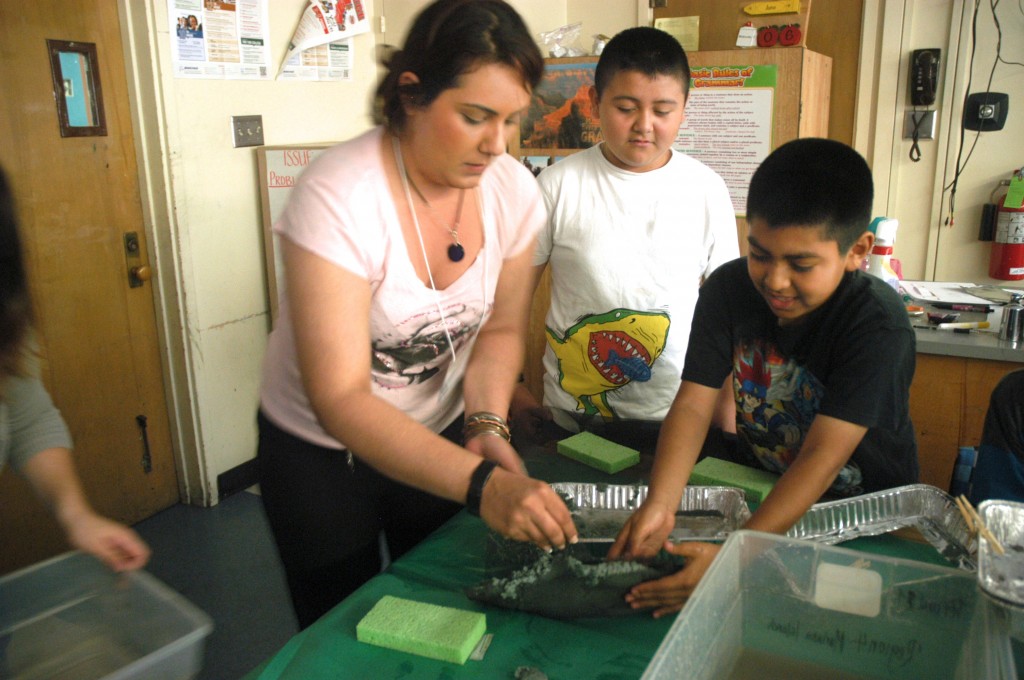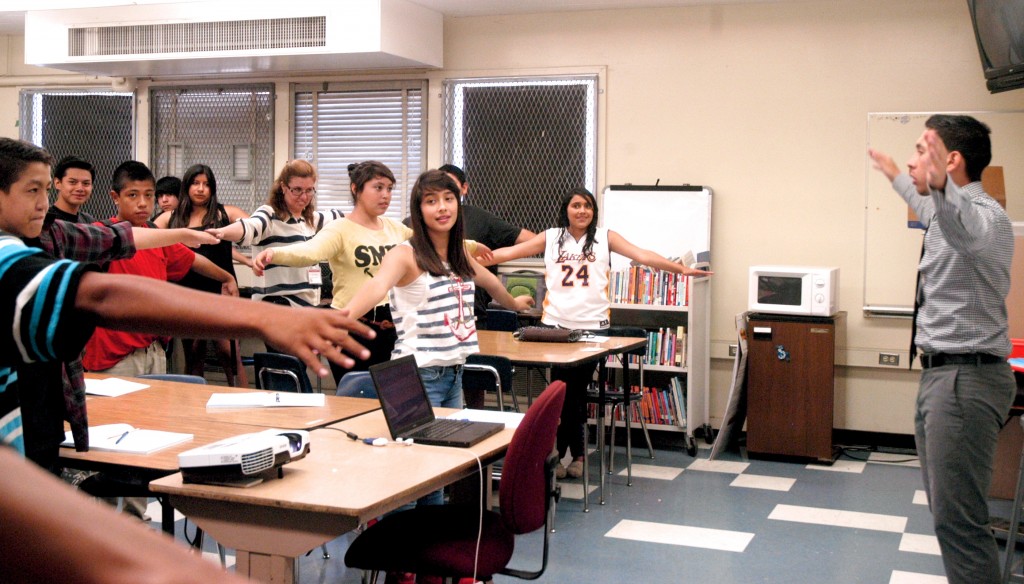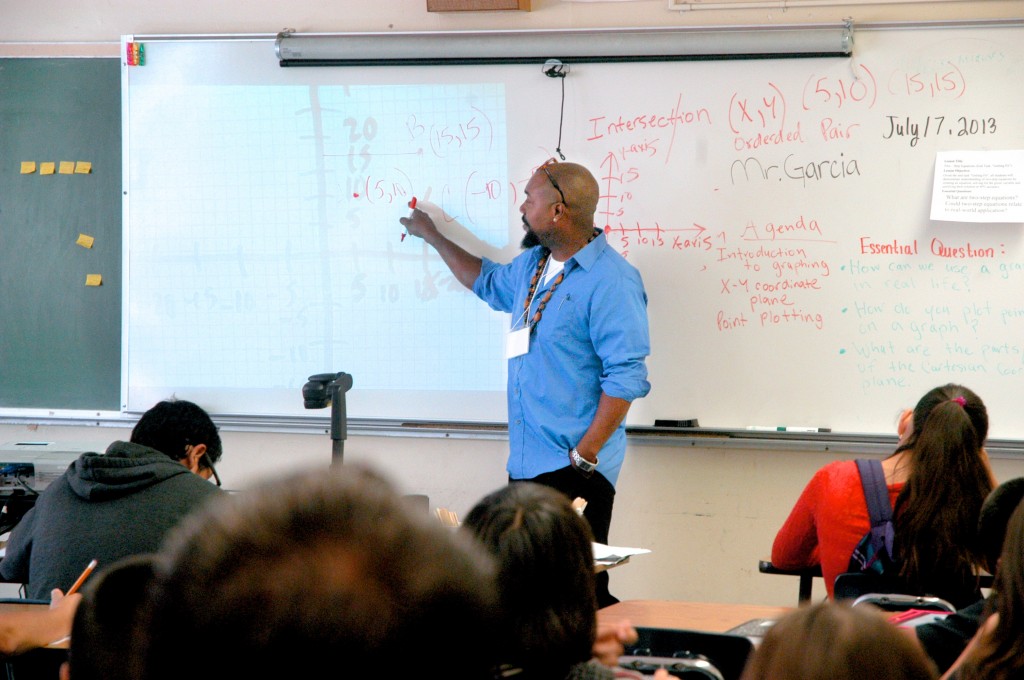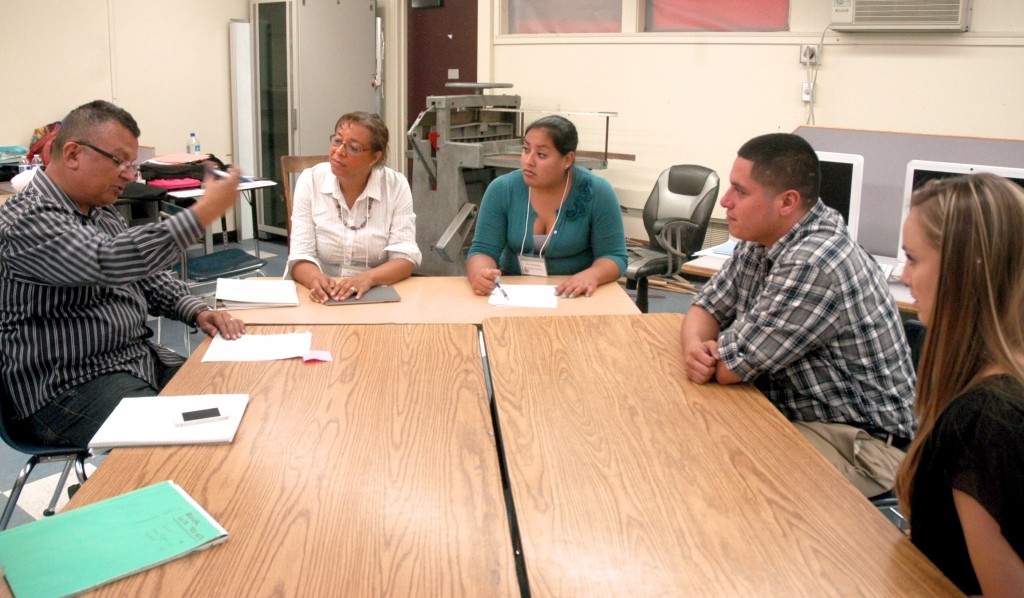
“It’s alive!” a child’s voice could be heard over the chatting and laughing of students excited with the soggy, messy task of turning old notebook pages and newspapers into usable paper. Over the din, Sasha Magidi (’13, B.A. liberal studies: math) kept them focused.
“Double-timing with the sponges, triple time, and then every time the water starts coming out of the sponges you have to drain it,” she instructed and encouraged.
In another room, teens were on their feet learning what looked to be dance moves. At the head of the class, Mario Romero had the class demonstrate positive, negative, zero and undefined graph slopes using arm movements. He then set them to work finding the slope formula between Brazilian national players Cristiano Ronaldo and Marcelo on a soccer pitch.
“I wish I learned math and science like this,” noted Kamal Hamdan, adjunct professor of teacher education and director of several grant programs at California State University, Dominguez Hills, namely Transition to Teaching (TTT), TTT Online, and Urban Teacher Residency (UTR), through which individuals with math or science degrees or mid-career professionals earn their single subject math or science credential. In the case of TTT Online, students can take classes from anywhere in the state.

Hamdan is at Gage Middle School in Huntington Park, overseeing a TTT/UTR lab school of approximately 300 students and 60 teachers.
But this isn’t a typical school day; it’s summer. And the majority of the teachers are students themselves, TTT and UTR candidates learning how to instruct, assess, and lead a STEM (science, technology, engineering and mathematics) class.
This is the second year CSU Dominguez Hills has offered a summer STEM program to students at Gage, something the school hasn’t been able to offer in several years due to budget cuts at Los Angeles Unified School District.
“If we didn’t offer this summer program these kids would be at home with nothing to do,” Hamdan said. “So we came in from Dominguez Hills and said we would like to offer your students a summer program; you benefit and our candidates benefit from the experience.”
Jason Garcia is one of the aspiring teachers working and learning at the lab school. A candidate in the TTT program, Garcia will begin teaching classes in the fall. This summer at Gage he is practicing his math instruction skills.
“He needs to acquire everything he can this summer so he has an even greater chance of making it during his first year of teaching,” Hamdan said. “He is a bright man who I know will do well. His greatest strength is he knows the students; he graduated from LAUSD, Washington Prep, and hopefully he will go back and teach there.”

Each of the 10 classes being offered through the summer program has a lead teacher, someone currently teaching at Gage or at another local school, and three to six prospective teachers. While one TTT or UTR student leads the class through a lesson, the lead teacher and other candidates observe and also assist the students.
During a break between classes–the youth each take a math-based and a science-based STEM class each day Monday through Thursday–a team of TTT/UTR students and the lead teacher go over the morning session. Lead teacher Ruben Hernandez complements TTT candidate Gayle Williams (’13, B.A, Africana Studies) on how she made real world connections to math concepts, in this case fractions.
“You asked ‘What’s their favorite show.’ You connected that sometimes we don’t get to see an entire show, we see a fraction of it, we see a portion of it. So you’re building some vocabulary with that too,” Hernandez tells her. “’Are fractions important?’ you asked. It seemed to me you were trying to build on a need to know… that’s good because students have a legitimate question in every class, ‘Why am I sitting here?’”
The number of teachers per class is the only difference from what the candidates will experience in a regular classroom. Hamdan said the summer program was designed to mimic real conditions, from class size to make up. Invitations were sent out to parents with students of all ability levels, from those scoring very low in math and science to gifted students and children with special needs.

“A typical classroom in an inner city school consists of far below basic, below basic, proficient and advanced. They are all there, but the majority is far below basic and below basic,” Hamdan said. “Our classes reflect as much as possible that diversity….Our candidates gain exposure to all sorts of students, how to address their needs, how to differentiate instruction.”
Alon Agua, who has a chemistry degree from University of California, Los Angeles and a master’s from CSU Los Angeles, and Christina Fintikakis, who received her chemistry degree from Cal Poly San Luis Obispo, are among a number of UTR teacher candidates at Gage.
During the day they teach, and in the late afternoon into evening, they switch into student mode taking classes at CSU Dominguez Hills. In a year and a half in the program they’ll have a credential and a master’s degree. It’s grueling, they admit, but worth it.
“It’s amazing. I love the fact that we get a chance to actually dive into the experience before getting into actual teaching,” said Agua, who like the other UTR students will begin their residency as student teachers when the new school year starts in August or September.
“We’re learning so much about theory (in the evening classes),” Christina agrees, “but in the lab school we’re learning all these practical things, which is kind of the point.”
The lead teachers are getting something out of the program as well. Kristi Hayes (’09, M.A. education), who teaches sixth grade science, English and environmental science at Gage, said what they’re doing this summer is what science and math classes should be like throughout the year. She’s also excited about the crop of new teachers.
“Last year it had been eight or nine years (that she has been teaching). Working with more young teachers and seeing more teachers who want to teach science the way it should be taught, it kind of rejuvenated my passion for the career,” said Hayes, who is currently enrolled in the Master Teacher Fellows program at CSU Dominguez Hills. “It makes me hopeful for the future generation of scientists.”
The lab school at Gage continues every other Saturday throughout the school year, with CSU Dominguez Hill credential candidates gaining experience teaching and Gage students receiving lessons designed to reinforce what they are learning Monday through Friday.
Gage is one of three lab schools set up through the statewide TTT Online program; the two others are K-8 Heber School in El Centro in Imperial County and Jim Maples Academy in Porterville in Tulare County. In addition to the hands-on teaching experience offered at the lab schools, one class in each school will also be equipped with cameras to enable live broadcast of classroom instruction that students in TTT online can observe and discuss.
For more information about TTT, UTR or other special teacher education program, visit www.csudh.edu/cps/soe/pathways, or call (310) 243-2668 for TTT or (310) 243-2337 for UTR.